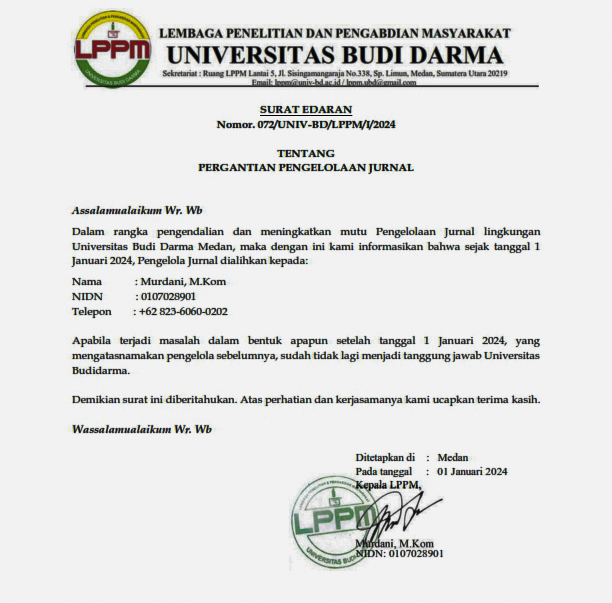Analisis Perbandingan Penerapan Metode MOORA dan SAW dalam Kelayakan Pemberian Bantuan Uang Kuliah Tunggal
DOI:
https://doi.org/10.30865/json.v3i4.4281Keywords:
Decision Support System, Single Tuition, MOORA, SAWAbstract
Single Tuition Fee (UKT) is a tuition payment rule that funds each student according to his economy, especially at PTN whose tuition fees are also determined from the student's economy. Students pay for the semester which is decided according to the single tuition fee minus the costs borne by the government, in other words each student only pays one component. At Budi Darma University, the payment of the Single Tuition Fee (UKT) has been determined by the campus by being able to pay in 6 installments per year in order to ease the payment of tuition fees to students. However, the number of students who meet the requirements in applying for UKT assistance makes it difficult for the campus in the selection process. Therefore, a decision support system is needed to solve a problem by applying the comparison of the Multi-Objective Optimization on the basis of Ratio Analysis (MOORA) and Simple Additive Weighting (SAW) by including weighting with the Rank Order Centroid (ROC) method to get accurate and effective results. From the test results, getting the best alternative that is considered worthy of single tuition assistance is in the same alternative, namely A7 on behalf of Zaza Mutiara Arini. Calculations using the MOORA method get the best preference value of 0.7391 while calculations using the SAW method get the best preference value of 0.8976.References
A. Nur, “Uang Kuliah di Masa Pandemi: Mendaras SK Rektor UIN AM tentang Keringanan UKT Mahasiswa,†pp. 5–8, 2020.
F. Abdullah, “TINGGI AGAMA ISLAM NEGERI DI SULAWESI SELATAN Fahri Abdullah Institut Agama Islam Negeri Bone , Indonesia,†vol. 17, pp. 683–693, 2018.
Wawan Firgiawan, Sugiarto Cokrowibowo, and Nuralamsah Zulkarnaim, “Komparasi Algoritma Saw, Ahp, Dan Topsis Dalam Penentuan Uang Kuliah Tunggal (Ukt),†J. Comput. Inf. Syst. ( J-CIS ), vol. 1, no. 2, pp. 1–11, 2019.
Ikhwan Nur Rois, “Implementasi Keringanan Uang Kuliah Tunggal bagi Mahasiswa di Era New Normal,†Jambura J. Educ. Manag., vol. 1, no. September, pp. 103–121, 2020.
Triase and Samsudin, “Implementasi Data Mining Dalam Mengklasifikasikan Ukt ( Uang Kuliah Tunggal ) Pada Uin Sumatera Utara Medan,†J. Teknol. Inf., vol. 4, no. 2, pp. 370–376, 2020.
N. Pranata and T. N. Safitri, “Sistem Pendukung Keputusan Menentukan Kelanjutan Dan Kinerja Keuangan Pada Usaha Produksi Gas Menggunakan Metode Rasio Likuiditas,†vol. 2, pp. 206–210, 2021.
T. Limbong et al., Sistem Pendukung Keputusan: Metode & Implementasi. Medan: Yayasan Kita Menulis, 2020.
R. P. Sari and F. S. Redha, “Sistem Pendukung Keputusan Pemilihan Distro Linux Menggunakan Metode Simple Additive Weighting (SAW),†J. Sist. Komput. dan Inform., vol. 2, no. 3, p. 348, 2021.
M. C. Quek, N. L. Chin, and S. W. Tan, “Optimum dna extraction methods for edible bird’s nest identification using simple additive weighting technique,†Foods, vol. 10, no. 5, 2021.
H. Gulo, “Sistem Pendukung Keputusan Pemilihan Kantor Pos Terbaik Menerapkan Metode WASPAS,†J. Inf. Syst. Res., vol. 1, no. 2, pp. 81–86, 2020.
D. W. T. Putra, S. NoviaSanti, G. Y. Swara, and E. Yulianti, “Metode Topsis Dalam Sistem Pendukung Keputusan Pemilihan Objek Wisata,†J. TeknoIf, vol. 8, no. 1, p. 1, 2020.
T. Hidayat and S. Komariah, “Pemilihan Siswa-Siswi Berprestasi Menggunakan Metode Weighted Product (WP) Studi Kasus SMP-Al Fitroh Tangerang,†J. Tek. Inform. Unis, vol. 7, no. 2, pp. 159–163, 2020.
R. Puspa and N. Nurahman, “Pembaruan Teknologi Informasi Untuk Sistem Pendukung Keputusan Pemberian Kelayakan Kredit Menerapkan Metode Profile Matching dan Metode Fuzzy Mamdani,†J. Comput. Syst. …, vol. 2, no. 1, pp. 77–83, 2020.
A. Yusni and Suprianto, “Menggunakan Metode Moora,†vol. 6, no. 2, pp. 2502–714, 2021.
J. T. Informatika, S. Fadli, M. Rizqi, and T. Informatika, “DENGAN METODE MOORA ( Studi Kasus : MTs N 1 LOMBOK TENGAH ),†vol. 2, no. April, pp. 23–30, 2019.
T. Elizabeth, “Sistem Pendukung Keputusan Pemilihan Asisten Dosen Menggunakan Metode SAW,†JATISI (Jurnal Tek. Inform. dan Sist. Informasi), vol. 7, no. 1, pp. 71–80, 2020.
E. T. Cahyanu, S. D. Lestari, and H. Hermawan, “Sistem Pendukung Keputusan Bagi Penerima Bantuan Siswa Miskin (BSM) Menggunakan Metode Simple Additive Weighting (SAW) di SMA Negeri 1 Raren Batuah Kabupaten Barito Timur,†J. Appl. Informatics Comput., vol. 3, no. 2, pp. 114–118, 2019.
H. B. Setyawan, “Sistem Pendukung Keputusan Seleksi Beasiswa Bantuan Belajar Mahasiswa Menggunakan Metode Modified-Simple Additive Weighting,†J. Sist. dan Inform., vol. 15, no. 1, pp. 13–21, 2020.
J. N. Wattimena, D. S. Urbasa, and P. Manuputty, “Beasiswa Bidikmisi Menggunakan Metode Saw ( Studi Kasus : Bag . Kemahasiswaan Universitas Victory Sorong ) the Support System for Acquisition Decision of Bidikmisi Scholarship Using Saw Method ( Study Case Student Affairs Part of Victory University in Sor,†J. Electro Luceat, vol. 6, no. 2, 2020.
nurahman Noprida aruanto, “Sistem Pendukung Keputusan Penilaian Kinerja Dosen Menggunakan Metode AHP,†JUMANJI (Jurnal Masy. Inform. Unjani), vol. 3, no. 01, p. 1, 2019.
A. Supiyandi, Andysah P. U. Siahaan, “Sistem Pendukung Keputusan Pemilihan Pegawai Honorer Kelurahan Babura dengan Metode MFEP,†vol. 4, pp. 567–573, 2020.
S. Palete and A. Hidayat, “YUME : Journal of Management Perhitungan Biaya Kuliah Tunggal Program Studi Diploma Universitas Fajar,†vol. 4, no. 3, pp. 87–94, 2021.
A. Karim, S. Esabella, and K. Kusmanto, “Analisa Penerapan Metode Operational Competitiveness Rating Analysis (OCRA) dan Metode Multi Attribute Utility Theory (MAUT) Dalam Pemilihan Calon Karyawan …,†J. Media …, vol. 5, pp. 1674–1687, 2021.
R. Khalida, B. Bangun, M. Mesran, and N. Oktari, “Penerapan Metode ROC dan Weighted Aggregated Sum Product Assesment (WASPAS) dalam Penerimaan Asisten Perkebunan,†J. Media Inform. Budidarma, vol. 5, no. 3, p. 937, 2021.
I. Arfyanti, “Penerapan Metode Technique for Orders Preference by Similarity to Ideal Solution (TOPSIS) dan Rank Order Centroid (ROC) Dalam Pemberian Beasiswa Kartu Indonesia Pintar (KIP),†J. Media Inform. Budidarma, vol. 5, no. 3, p. 922, 2021.
K. Nisa, “Metode Moora Dan Waspas Untuk Pengambilan Keputusan Penentuan Prioritas Dalam Peningkatan Kualitas Mata Pelajaran,†J. Teknol. Inf., vol. 4, no. 1, 2020.
J. D. Manik and A. R. Samosir, “Penerapan Metode Simple Additive Weighting dalam Penerimaan Siswa Magang pada Universitas Budi Darma,†sudo J. Tek. Inform., vol. 1, no. 2, 2022.
I. J. T. Situmeang, S. Hummairoh, S. M. Harahap, and Mesran, “Application of SAW (Simple Additive Weighting) for the Selection of Campus Ambassadors,†IJICS (International J. Informatics Comput. Sci., vol. 5, no. 1, pp. 21–28, 2021.
S. H. Sahir, R. Rosmawati, and K. Minan, “Simple Additive Weighting Method to Determining Employee Salary Increase Rate,†Int. J. Sci. Res. Sci. Technol., vol. 3, no. 8, pp. 42–48, 2017.
Asminah, “Penerapan Metode Simple Additive Weigthing Untuk Penentuan Level Kondisi Penyandang Disabilitas,†Build. Informatics, Technol. Sci., vol. 3, no. 4, pp. 559–565, 2022.
S. K. Simanullang and A. G. Simorangkir, “Sistem Pendukung Keputusan Penerimaan Calon Karyawan Menggunakan Metode Simple Additive Weighting,†TIN Terap. Inform. Nusant., vol. 1, no. 9, pp. 472–478, 2021.
F. Sembiring, M. T. Fauzi, S. Khalifah, A. K. Khotimah, and Y. Rubiati, “Sistem Pendukung Keputusan Penerima Bantuan Covid19 menggunakan Metode Simple Additive Weighting ( SAW ),†TIN Terap. Inform. Nusant., vol. 11, no. 2, pp. 97–101, 2020.
Downloads
Published
How to Cite
Issue
Section
License

This work is licensed under a Creative Commons Attribution 4.0 International License
Authors who publish with this journal agree to the following terms:
- Authors retain copyright and grant the journal right of first publication with the work simultaneously licensed under Creative Commons Attribution 4.0 International License that allows others to share the work with an acknowledgment of the work's authorship and initial publication in this journal.
- Authors are able to enter into separate, additional contractual arrangements for the non-exclusive distribution of the journal's published version of the work (e.g., post it to an institutional repository or publish it in a book), with an acknowledgment of its initial publication in this journal.
- Authors are permitted and encouraged to post their work online (e.g., in institutional repositories or on their website) prior to and during the submission process, as it can lead to productive exchanges, as well as earlier and greater citation of published work (Refer to The Effect of Open Access).





